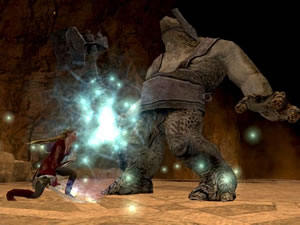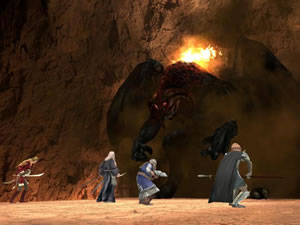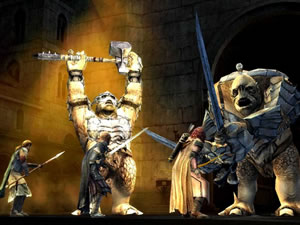A dead ringer.
Disappointment: that feeling you get when, having asked your parents for a car,
you find a Micro-Machine in
your Christmas stocking instead. It’s also a word
that accurately describes EA’s new The Lord
of the Rings: The Third Age for the PS2, Xbox, and Gamecube. As promising
as a role-playing game based on The Lord of the Rings mythos sounds, The
Third Age‘s reality is one of strict linearity, wacky plot foibles,
and generic turn-based action.
You begin the game as the colorless Berethor, Guard of Gondor. You’re making
your way to Rivendell to meet with your Captain, famed Fellowship member Boromir,
when you are waylaid by a band of Nazgul who promptly kick your ass. Before they
can finish you off, a she-elf with huge nostrils summons a torrential downpour
of horses to drive the fiends away and save your life. Then you team up, and
your journey begins as you form a second Fellowship.
That’s right, a SECOND Fellowship. Let’s all give a warm welcome to the LOTR bench warmers!
The bulk of the plot unfolds through “Epic Scenes,” essentially montages of clips taken straight from the movies with voiceover from Ian McKellen’s Gandalf, who loosely explains what’s going on in the world. I say loosely, because the entire plot functions as a pretext for your ridiculous “other” Fellowship to wind up in every single location from the three movies as well as take part in all the most significant battles.
For example, in the movies and books, Gandalf faces the Balrog alone. But in
the game, your group runs up from behind and you fight it together. For a game
that completely depends on the movie for its plot, it sure does take a lot
of temporal, spatial, and factual liberties.
Whereas a good RPG should enmesh you in a sticky plot and bring its characters
to life, The
Third Age uses its plot like a leash and drags you through one familiar
scene after another. The game is so linear that you’ll feel like you’re on a
guided tour of the LOTR movie-set. From start to finish, you’ll progress down
one long path with stops at every memorable event from the films. Remember the
three-way fork in Moria where Gandalf followed his nose and led his party down
the right path? Well, your party has to go down all three, and at the end of
one is a treasure chest, and the other two are different parts of a lever-pulling
puzzle. While there’s no getting lost in The Third Age, you might lose your mind
wishing you could explore more freely.
Not that it would matter much thanks to The Third Age‘s random
encounters and derivative turn-based battles. In an attempt to make the random
encounters a bit more predictable, EA created two different indicators to let
you know when you’re approaching a skirmish. If you see a glowing Eye of Sauron, you’re in a dangerous area and you’ll definitely be attacked if you stick around. A glowing palantir, on the other hand, means you’re approaching an area with enemies in it, and you will definitely be attacked if you continue on the same path.
Even though these two measures make the random encounters more bearable, knowing
that if you step on a panel something scary will jump out is what you look
forward to in Halloween fun houses, not role-playing games. Boo.
The combat system is basically what you’d expect to find in any Final
Fantasy game. Each character has hit points and action points (see “mana” or “magic”),
and as you fight, a meter builds that will eventually allow you to engage “Perfect
Mode,” in which you’ll summon some beast from the LOTR universe to attack one
of your opponents for massive damage. You may quickly switch between combatants
with the tap of a button.
 Each character relies on some form of special attack to either benefit the party or deal greater damage to foes. Berethor, for example, has sword-based special attacks, as well as Leadership-based buffs. Every time Berethor uses a Leadership skill, he’ll gain a Leadership point that will go towards learning a different Leadership skill of your choosing. This system seems pretty sensible in the early parts of the game, as skills don’t cost many points, and being rewarded through use feels realistic. However, in the late game when a new skill costs one hundred points, you’ll have to do some real grinding.
Each character relies on some form of special attack to either benefit the party or deal greater damage to foes. Berethor, for example, has sword-based special attacks, as well as Leadership-based buffs. Every time Berethor uses a Leadership skill, he’ll gain a Leadership point that will go towards learning a different Leadership skill of your choosing. This system seems pretty sensible in the early parts of the game, as skills don’t cost many points, and being rewarded through use feels realistic. However, in the late game when a new skill costs one hundred points, you’ll have to do some real grinding.
Then again, The Third Age is almost all grinding, anyway. With
no towns to putz around in, NPCs to talk to, or stores to check out, you’ll be
wearing whatever you find as you repetitively battle through area after area.
Oddly, everything you find is in a treasure chest. You won’t be looting corpses
or searching through bookshelves, you’ll be opening the same treasure chests
everywhere you go, from Isengaard to Elsinore.
In the game’s coolest touch, equipment that you gain in battle or take from chests
actually shows up on your characters when it’s applied. While this isn’t a revolutionary
concept, all of the pieces are straight from the films’ armories, and they’re
all highly detailed and look authentic.
According to EA, The Third Age has its own brand of side-quests.
According to me, they lied. For example, if you kill all the Wargs at the choke-points
you are required to pass through, you will have completed a side-quest!
Way to kill two birds – and your game – with one stoned concept.
To be fair, The Third Age‘s gameplay is not broken or anything
and does deliver a decent helping of traditional turn-based action. It can be
pretty fun whupping on trolls, leveling up and whupping on more trolls. Just
don’t expect the whupping to feel very new or particularly interesting.
Any time you clear a region, you can go back and play its Evil Mode version. This is basically a representative battle from each of the region’s areas with you playing as the bad guys against a severely crippled version of your party. It’s a very cool idea and adds some nice replay value.
Unfortunately, the Evil Mode A.I. is terrible. Once when I was playing as a group of Orcs, the dwarf kept trying to use Goblin Bane, an attack that only hurts Goblins, against my Orcish Archers. Short AND stupid.
 There’s also an option to play the main Story mode cooperatively with a friend.
There’s also an option to play the main Story mode cooperatively with a friend.
As fun as such a feature might be in a real-time game such as X-Men:
Legends,
cooperative turn-based battles are pretty boring. Things are slow enough throughout
the single-player game without having to wait for you friend to accidentally
attack the wrong Orc.
The Third Age‘s strongest suit is its look. The environments
are particularly lovely thanks to gorgeous lighting effects, great texture-mapping
and the sheer thrill of traipsing through realistically rendered LOTR locales.
The spell effects are also extremely impressive. When Idrial the
elf casts haste, lightning from her sword will slowly spiral upward before culminating
into a ball, which she’ll then smack over to her target who will roar and brandish
his weapon with energized approval. The game captures the cinematic quality of
the films wonderfully.
The large environments come at a price, however, as none of the versions run very smoothly. The Xbox version slows down the least, naturally, but running while panning the camera will even bring that beast to its knees on most occasions.
The music is probably The Third Age‘s finest feature, mostly
because it’s yanked straight out of the films. The sound effects are a mixture
of hyper-realistic metallic clinks and ultra-surreal “SHHHROOOWG’s and “BLLLLLIZZZZZTS’s
when any of The
Third Age‘s over-the-top spells are cast. The result is a very loud
game with terrible voice-acting.
The best The Third Age has to offer has already been seen in The
Two Towers and The Return
of the King action games, both of which benefited from hectic real-time combat
and the ability to use actual characters from the movies instead of poorly conceived
stand-ins. If you’re dying to play a Middle-Earth RPG, we recommend waiting to
check out Middle-Earth
Online, if it ever comes out. And if you just can’t wait
to relive all the coolest moments from the films, spare yourself a few bucks
and go rent the movies.
-
Great graphics
-
Interesting Evil mode
-
Bizarro Fellowship?
-
Completely linear with few real side-quests
-
Derivative gameplay











